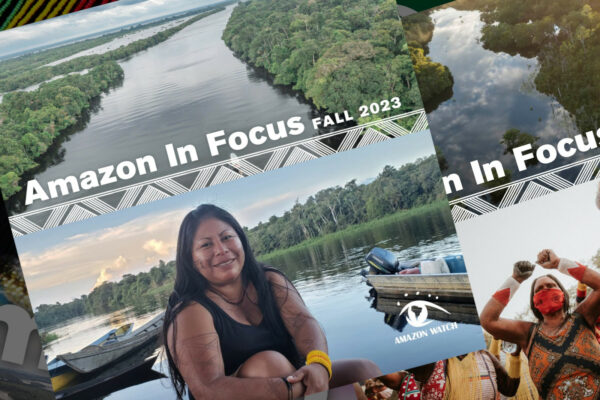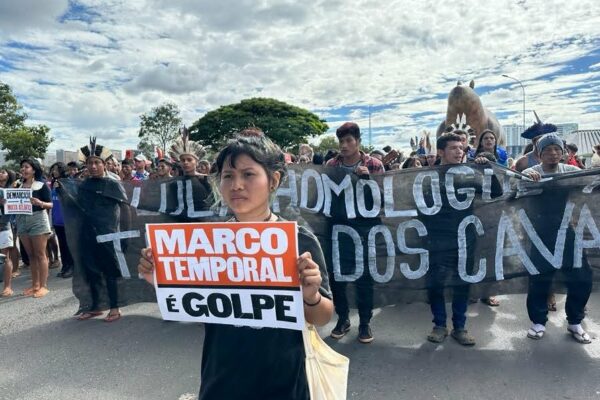As the world’s largest rainforest, with the highest concentration of biodiversity and one of the largest freshwater reserves on the planet, the Amazon is at the center of the environmental debate in Brazil. That was no different at the United Nations Conference on Sustainable Development this year, also known as Rio+20.
The Brazilian government’s policies regarding the Amazon were strongly criticized by environmentalists, scientists, indigenous peoples and traditional communities during events parallel to Rio+20. Held in Rio de Janeiro from June 20 to 22, it was the perfect setting for the government to present its action plan to reduce deforestation and protect the vast rain forest.
The criticisms focused on three points. First was the group of hydroelectric projects in the region, particularly the construction of the Belo Monte plant on the Xingu River basin, which will become the third largest hydroelectric power plant after Three Gorges in China and Itaipu, which is shared by Brazil and Paraguay. The other grievances are about deforestation and a law passed by the Senate to reduce conservation areas.
Brazil has more than 140 hydroelectric projects of varying power in the Amazon, for a total of more than 40,000 MW, by far the major part of over 60,000 MW planned for total projects in the country. Belo Monte dam, in the state of Pará, is slated to provide 11,000 MW alone.
In April, two months before Rio+20, the government received another notice from the Inter-American Commission on Human Rights, or IACHR, part of the Organization of American States, about the possible effects from the construction of Belo Monte on the indigenous peoples and other traditional communities in this area of the Amazon.
On April 1, 2011, the IACHR granted precautionary measures for the members of the indigenous communities of the Xingu River Basin in Pará, Brazil: the Arara of Volta Grande do Xingu; the Juruna of Paquiçamba; the Juruna of “Kilómetro 17”; the Xikrin of Trincheira Bacajá; the Asurini of Koatinemo; the Kararaô and Kayapó of the Kararaô indigenous lands; the Parakanã of Apyterewa; the Araweté of the Igarapé Ipixuna; the Arara of the Arara indigenous lands; the Arara of Cachoeira Seca; and the Xingu Basin indigenous communities in voluntary isolation.
The request for precautionary measures to the IACHR alleged that “the life and physical integrity of the beneficiaries is at risk due to the impact of the construction of the Belo Monte hydroelectric power plant.”
In July 2011, after a response from the Brazilian government ensuring it was taking measures to protect the territories and rights of indigenous peoples, the IACHR asked the government to adopt concrete measures to “protect the lives, health, and physical integrity of the members of the Xingu Basin indigenous communities in voluntary isolation … [and] the cultural integrity of those communities.”
In response to pressure from indigenous organizations, environmentalists and the IACHR itself, the government created this January an Inter-ministerial Working Group to develop studies for the regulation of the International Labour Organization’s Convention 169 concerning Indigenous and Tribal Peoples, which provides for the consultation of communities that would eventually be affected by development projects. The absence of these consultations with indigenous and Afro-Brazilian peoples who could be impacted by some projects in the Amazon has been criticized by national and international bodies.
No to dams
In Rio+20, Belo Monte was naturally the subject of several side events, especially at the People’s Summit. On June 18, the French nongovernmental organization Planète Amazone presented the Kayapo people a petition with 350,000 signatures opposing the construction of Belo Monte, which in turn the community will turn over to Brazilian President Dilma Rousseff.
“We will bring everything to President Dilma. It is especially for her. To say that the Brazilian indigenous community is not alone,” said Marcos Apurinã, from the Coordinating Body of Indigenous Organizations of the Brazilian Amazon, or COIAB for its name in Portuguese, during the People’s Summit.
On June 19, a “human banner” was organized by some 1,500 people in downtown Rio de Janeiro, to symbolize a river free of dams or other forms of aggression.
“We need to draw the attention of the governments of Brazil and the rest of the world to stop these dams. How can people live without the rivers and their fish and forests?” said chief Raoni, a historic figure of Brazil’s indigenous population.
The demonstration, organized by the Articulation of Indigenous Peoples of Brazil, or APIB, had the support of organizations like the Global Campaign for Climate Action and Amazon Watch that supported Brazil’s need to take greater steps toward other sources of energy.
The multitude of hydroelectricity projects in the Brazilian Amazon were also central to discussions at the ninth Free Earth Camp for Good Living and a Full Life, held as a part of the Peoples’ Summit by indigenous organizations in Brazil and around the world like the Coordinating Body of Indigenous Organizations of the Amazon River Basin, or COICA, the Andean Coordinating Body of Indigenous Organizations, or CAOI, the Indigenous Council of Central America, or CICA, and the Continental Council of the Guarani Nation, or CCNAGUA.
The Free Earth Camp Final Declaration rejected major hydroelectric projects in Brazilian indigenous territories like the Belo Monte and Jirau dams, among others.
The controversy over the hydroelectric plants is related to another point of criticism of Brazil’s policies regarding the Amazon: the issue of existing Conservation Units in the Amazon. Less than a month before Rio+20, on May 29, the Senate approved a bill that reduces the conservation units’ area to make possible the reservoirs for hydroelectric plants planned in the Amazon — and the flooding that goes with them —, Brazil’s new energy frontier.
With the project, which was the result of a bill introduced to Congress by the federal government, the boundaries of eight conservation units were altered, of which four have already lost land in benefit of the predicted flooding by dams for the power plants of São Luiz do Tapajós, Tabajara, Jatoba, Santo Antônio and Jirau. These are already under construction.
Deforestation
The third critique to the federal government regarding the Amazon was deforestation, with its impact on the destruction of biodiversity and the emission of greenhouse gases. Fires, deforestation and other forms of inappropriate land use represent 70 percent of Brazilian emissions.
At Rio+20, the Brazilian government presented several of its activities related to the Amazon, including the result of policies to counter deforestation. Since 2004, when deforestation reached 2.7 million hectares (6.75 million acres), there has been an annual decline. From August 2010 to July 2011, it dropped to 642,000 hectares (1.6 million acres).
But environmentalists maintain that these rates of deforestation are still very high in the Amazon, which has lost 20 percent of its original area.
The Brazilian government also showed the results of the Amazon Region Protected Areas program, or ARPA, which already covers 15 percent of the region. ARPA provides training in protection and supervision of the areas, as well as in the environmental, financial and physical monitoring of its own program to 95 conservation units in this biome, with a total of 58 million hectares (145 million acres).
“There are 22 million people who live in the Amazon and expect a better standard of life,” said Secretary of Biodiversity and Forests Roberto Cavalcanti at the end of the event regarding the ARPA results.
During the same meeting, the Ministry of Environment and the environmental organization WWF-Brazil met with international financial institutions to sign a multilateral agreement designed to raise US$250 million before 2019, and another $35 million in the following years as a way of strengthening and expanding ARPA.













